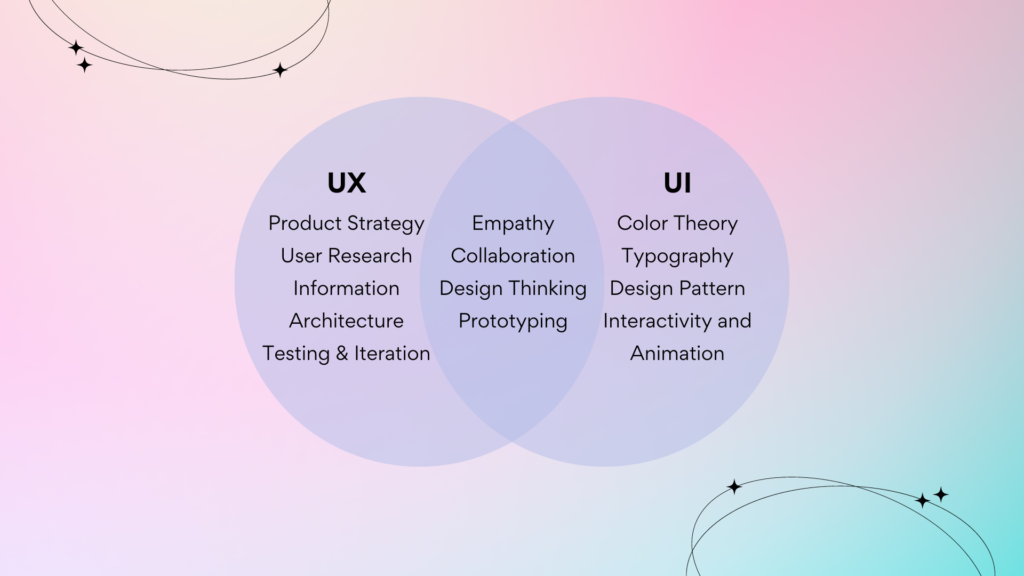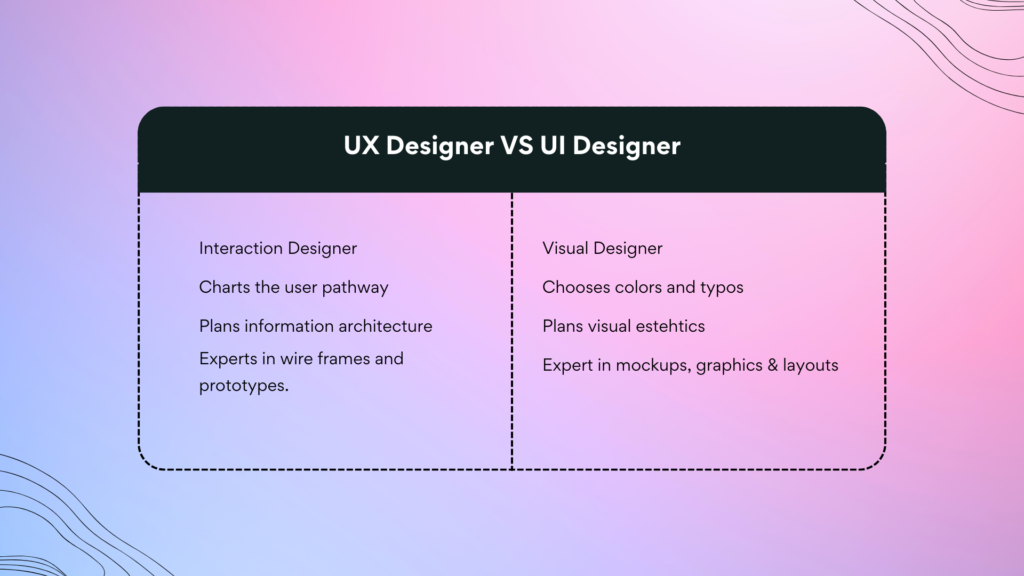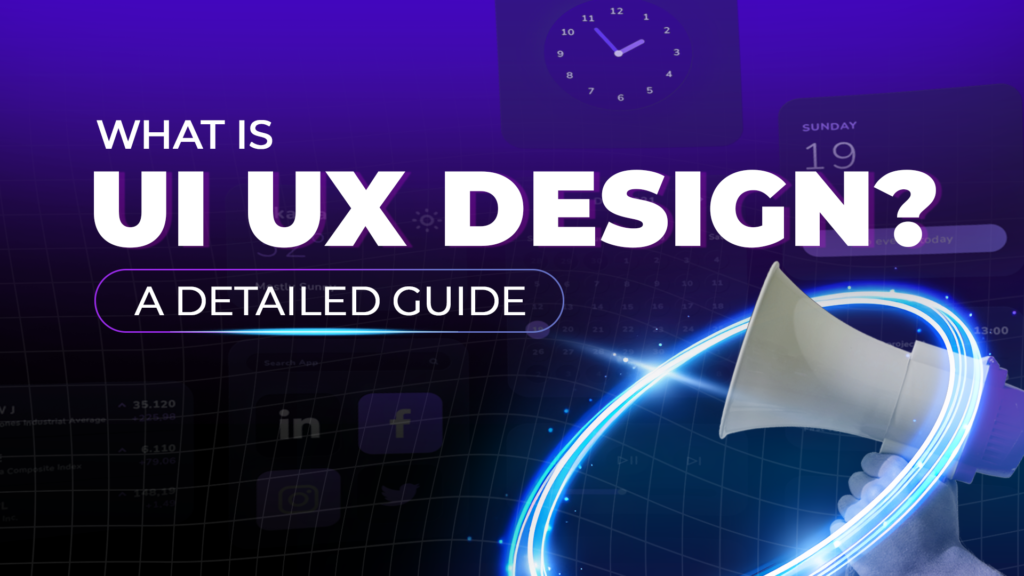Introduction
Have you ever wondered what makes one digital application more enjoyable to interact with than the other? The answer is UI/UX design. It is fundamental to creating digital products, ensuring they are visually appealing, intuitive, and user-friendly.
UI and UX designers are responsible for designing products that satisfy users’ needs and prioritize ease of interaction, but how do they do that? In this article, we will discuss in detail the difference between UI and UX design, how they manage to create products that we love, and what the future is like for UI and UX design.
Key Takeaways
● UI focuses on the visual elements, while UX ensures the overall experience is satisfying.
● Both UI and UX design are critical for creating products that look good and are functional.
● Though UI and UX have distinct roles, UI and UX must work closely together to create beautiful and user-friendly products.
● Skills for UI design include visual design and prototyping, whereas UX requires user research and empathy
● New technologies like AI will shape future trends in UI/UX. To remain relevant, designers must incorporate technology while keeping user’s needs at the center.
What is UI/UX design?
Generally, both UI and UX refer to designing user interfaces and user experiences for products and services that are intuitive and satisfying for users. However, there are slight differences between the two.
UI design focuses specifically on how a product’s interface looks and feels. This includes
● Screen layout
● Buttons
● Menus
● Micro-interactions and aesthetics
UX design deals with the user’s overall product experience, including utility, ease of use, and emotion. But for a product or a service to be truly optimized for the user, a close collaboration between UI and UX designers is required to ensure an enjoyable experience.
What to Know About UI UX Design?
Today, users interact with businesses and their products primarily digitally. Due to this, UI and UX have become increasingly vital in crafting functional and user-friendly products.
Here is what you need to know about UI and UX design;
UI Design
What is UI Design?
UI design refers to the process of designing interfaces that primarily focus on looks and style. UI elements are the first touchpoint with the product and involve choosing the correct design elements to create an intuitive and visually appealing user interface.
Why is UI Design Important?
UI Design is crucial because it shapes a customer’s opinion about the product. It is through interaction with the UI that users develop opinions about the product. A good UI can help retain and even increase the customer base, while a bad UI can force customers to shift.
What Do UI Design Services Offer?
Listed below are some practical solutions offered by UI Design services;
● Custom designs for visuals,
● Interactive elements
● Animations,
● Ensuring accessibility and responsiveness
What are UI Design Principles?
UI Design Principles are guidelines that help designers create user interfaces that are both functional and visually appealing. These principles include:
● Consistency: Keep user interfaces uniform across the product for familiarity and ease of use.
● Shortcuts: Enable expert users to navigate faster through familiar shortcuts.
● Feedback: Provide clear and informative feedback for user actions.
● Sequence of Actions: Design a sequence of actions to provide users a sense of completion.
● Error Prevention: Design interfaces to prevent errors and provide clear instructions for correction when they occur.
● Reversibility: Allow users to quickly undo actions to alleviate the fear of making mistakes.
● User Control: Users should feel controlled, with the interface responding predictably to their actions.
● Reduced Memory Load: Design to minimize cognitive load, making it easier for users to interact with your product.
What does a UI designer do?
Below are some of the tasks UI designers do:
● Designing Visual Elements: Crafting the look of buttons, icons, and typography to ensure the interface is engaging and readable.
● Creating Layouts: Organizing interface components efficiently to optimize user interactions and accessibility.
● Prototyping: Developing interactive prototypes to test and refine the interface design before final development.
What are the Skills Required for UI Design?
Here are some skills required to excel in UI design:
● Visual Design: Understanding of layout, color theory, typography, and brand identity.
● Interaction Design: Knowledge of how users interact with applications and designing for ease of use.
● Prototyping: Ability to create mockups and prototypes to test design concepts.
● User Research: Skills in gathering and interpreting user feedback to guide design improvements.
● Animation: Understanding how to use motion and interaction to enhance the usability and appeal of the interface.
● User Empathy: Ability to understand and anticipate user needs and behaviors to create intuitive and user-friendly designs.
● Technical Skills: Knowledge of design software (e.g., Sketch, Adobe XD) and basic understanding of front-end development languages (e.g., HTML, CSS) to effectively communicate design intentions to developers.

UX Design
What is UX Design?
UX Design focuses on optimizing the overall experience of users as they interact with a product or service. Understanding user needs and designing the entire journey from initial interaction to final outcome are all steps involved in creating a smooth UX design. UX designers also ensure that the process is smooth, intuitive, and fulfilling.
Why is UX Design Important?
UX Design is crucial because it directly influences user satisfaction and loyalty. A superior user experience increases engagement, reduces frustration, and encourages long-term user retention by ensuring the product meets and exceeds user expectations.
What Do UX Design Services Offer?
UX Design services provide comprehensive strategies to enhance user satisfaction and engagement. These services include user research, usability testing, interaction design, and content strategy. They aim to create products that offer seamless, meaningful, and relevant experiences tailored to the users’ needs and behaviors, thereby improving the overall effectiveness and success of the product.
What are UX Design Principles?
Here are some UX design principles designers should know to create interactive user experiences:
● User-centricity: Focus on solving user problems.
● Consistency: Uniform design across all elements.
● Hierarchy of Navigation: Organize content for easy navigation.
● Context: Design with the user’s environment in mind.
● User Control: Allow users to undo actions quickly.
● Accessibility: Ensure designs are usable by everyone.
● Usability: Make products easy and efficient to use.
What does a UX designer do?
UX designers focus on creating enjoyable user experiences by deeply understanding user behavior and preferences. A UX designer’s role encompasses
● Design interfaces and experiences.
● Analyze user feedback.
● Understanding User Needs
● Designing Wireframes And Prototypes
● Conducting User Research And Tests
● Improving The Usability And Accessibility Of Products.
What are the Skills Required for UX Design?
Listed below are some important skills required to excel in the field of UX design:
● Visual and UI Design Skills: Focuses on creating visually appealing and functional product interfaces.
● User Research and Analysis: Involves collecting and analyzing data to understand user behaviors and needs.
● Information Architecture: Organizing the content within a product to make it easily accessible.
● Wireframing: Drafting a basic interface layout to plan the structure before the detailed design.
● Prototyping: Developing a functional product preview for testing and feedback.
● Empathy: Understanding and sharing users’ feelings to create more user-centered designs.
● Critical Thinking: Evaluating facts to form a judgment crucial for solving design problems.
● Communication & Collaboration: Effectively working with and conveying ideas to team members and stakeholders.
● Time Management: Efficiently organizing work to meet deadlines and project goals.
● Continuous Learning: Keeping skills updated with the latest UX trends and methodologies.
● Technical skills: UX designers must be equipped with languages like HTML, CSS, etc., and have a firm grip over design software.
Why is UI/UX Design Important?
UI/UX design is essential because, without it, developers risk spending significant time and money building complex tools that ultimately confuse or fail to meet user needs. And today, where businesses compete fiercely in the digital domain, the first impression sets them apart from a new customer. Effective UI/UX design ensures that the first impression is ever-lasting and that the user experience adapts to how users expect to find information or complete tasks.
This leads to higher customer satisfaction and increased conversion rates. Ultimately, this reduces development costs and end-products that customers actually enjoy using rather than feeling forced.

The Relationship Between UI and UX
Look at it this way: UI design is like the paint coat on a car, and UX design is the engine that drives it. A great product experience starts with UX, followed by UI. Both must be perfectly executed for a fulfilling experience.
What is the Difference Between UI and UX Design?
Although both are incomplete without one another, here are some common differences between UI and UX design:
● UX design is focused on the overall experience, while UI focuses on specific components that enhance the user experience.
UX design takes a big-picture view, focused on users’ total end-to-end experience with a product or service. In contrast, UI design zooms in on crafting specific interfaces that support that broader experience. Effective UX relies on UI components.
● UX is based on structure and designing the interaction, while UI is based on creating surface-level design components and visuals.
UX design involves structuring the user journey and interaction model through information architecture, flowcharts, prototypes, etc. UI design brings this structure to life visually and functionally through interfaces. UX plans the roadmap, while UI paves and marks the roads.
● UX involves developing information architecture and studying the interaction journey, while UI involves developing interactive elements.
UX designers map out how a user will move through a product. UI designers use this information to place components like buttons, menus, and forms that enable those interactions. UX strategic planning sets the stage for tactical UI design.
● UX is tangible, while UI is tangible.
User experiences an overall relationship with a product. User interfaces consist of concrete, visible components like screens, components, icons, etc. UX is felt, while UI is seen.
● UX is the sum of experiences, while UI shapes individual experiences
UX refers to a person’s overall relationship with a product or service. UI specifically shapes each touchpoint and moment of interaction through careful selection and organization of interactive components like buttons, menus, etc.
What are the Similarities Between UI and UX Design?
Here are some similarities between UI and UX in enhancing the overall user experience:
● User-Centered Focus
Both UI and UX design keep the end user at the center throughout the design process. Rather than making assumptions, deep research, and testing are conducted to create solutions that meet user needs and wants.
● Enhance Usability
UI and UX design share a common aim of creating intuitive interfaces and experiences for users. They strive to remove complexities and confusion that get in the way of a user completing their desired tasks. Whether simplifying navigation or clarifying messaging, UI/UX both enhance usability.
● Iterative Design Process
UI and UX projects typically follow a dynamic, iterative process that involves research, ideating potential solutions, prototyping concepts, user feedback, and refining the designs after each cycle.
● Attention to Detail:
Careful attention to subtle details in layout, interactions, animations, etc., that anticipate user needs or add delight is crucial across both UI and UX design.
● Visual Communication:
While UX strategy focuses on the big picture, communication skills are still essential for conveying ideas and contexts. UI and UX designers must communicate complex ideas to stakeholders through sketches, workflows, wireframes, prototypes, etc.
● Collaboration
UI and UX designers not only collaborate closely across the design process but also work with developers, engineers, content producers, and clients to bring the best solutions to the table.
How Do UX and UI Design Work Together?
Though different in focus, UX and UI design are tightly interdependent disciplines that must collaborate closely to create great products. Typically, the design process flows with UX designers conducting upfront user and market research to gain insights that inform the information architecture and interaction design. UX designers map the user journey, drafting key workflows and processes that outline the experience.
UI designers then develop prototypes to create a visual interface based on the research by UX designers. They design layouts, micro-interactions, visuals, content, etc, to craft a holistic user experience.
Developing a user-friendly product is an iterative process where both UI and UX use testing and feedback to refine the details at every step. Bad UX results in confusing UI, while bad UI undermines good UX.
Challenges in UI/UX Design
Listed below are some common challenges faced by UI/UX designers:
● Tight Deadlines
UI and UX designers often face tight deadlines, pushing them to work faster than ideal. This rush can lead to lower-quality designs, insufficient testing, and inadequate research, potentially missing meeting user needs. Such a fast-paced environment can also strain the collaboration between UI and UX teams, making it hard to integrate their efforts.
● Little Knowledge About User Expectations From Product
The best way to know what is expected of your product is to ask the consumer. But sometimes, this may not happen due to time constraints. Skipping direct engagement with users through interviews, observations, and feedback means designers could misinterpret user feelings towards a product. Assuming user expectations without research makes tailoring experiences to the audience extremely challenging.
● Little Knowledge About the Target Audience
A successful product depends on understanding user priorities and preferences deeply. Designing without insights into the target audience can lead to products that don’t align with user expectations, desires, and thinking patterns.
● Balancing Features And Usability
As product features and scope expand, the complexity for users increases, making it harder for them to find and use these features effectively. UI/UX design should simplify and organize features and information architecture to maintain usefulness without overwhelming users with too many options or an overloaded interface.
● Compromising Design Or Usability
UI and UX designers should prioritize usability and user-centric approaches over merely achieving a specific look or being first to market. Neglecting these principles can result in dissatisfaction and poor user experience.
Future of UI/UX Design
Technology is rapidly changing, and so is the future of UI UX design service providers. In the recent years, we have seen a huge implementation of AI. VR, AR, and voice interfaces like those found in smart homes are all common examples of AI applications. In the near future, it is expected for UI and UX designs to integrate changing technology to meet users’ needs and create satisfying experiences.
Yet, this wave of innovation introduces complexities for designers to overcome. It will be difficult for designers to ensure usability while navigating rapidly evolving technology. But by conducting thorough research and prioritizing a user-centric approach focusing more on what the user wants from the product rather than overloading the product with features and complicating it, UI and UX designers can both collaborate and develop enjoyable products.
FAQs
What is UI UX design in simple words?
UI UX design focuses on creating user interfaces (UI) that are visually appealing and user experiences (UX) that are intuitive. UI is about how things look, and UX is about how things work from the user’s perspective.
Is UX design the same as UI design?
No, UX design and UI design are not the same. UX design is concerned with the user’s overall experience, while UI design specifically focuses on the visual and interactive elements of a product’s interface.
Is UI UX Design the Same as Web Design?
While web design is about creating websites, UI/UX design can apply to any digital interface, including mobile apps, software, and even physical devices with digital controls.
Is UX/UI design hard to learn?
Learning UX/UI design can be challenging due to its wide range of skills, including visual design, user research, and interaction design. However, dedication, practice, and access to the right resources make it achievable for many people.
Does UI UX require coding?
Generally, UI/UX design services does not require coding. However, having a basic understanding of coding can enhance a designer’s toolkit, making it easier to communicate with developers and create more appealing designs.
Should I focus on UI design or UX design?
It depends on your interests and career goals. If you’re visually oriented and enjoy making things look good, focus on UI design. UX design might be more suitable if you’re interested in research, strategy, and solving user problems.
Conclusion
UI and UX design collaborate closely to create engaging digital products. UI design focuses visually on how interfaces look and function, while UX design focuses on the overall user experience. Together, they iterate designs based on research and testing to refine experiences that are intuitive, satisfying, and engaging. As technology evolves, UI/UX design will continue balancing innovation with usability by putting user needs first. Advancements bring opportunities to enhance interactions but also risks of complicating interfaces. However, focusing on users will remain crucial for the success of UI/UX design as technology continues to evolve rapidly.
Bilzimo is a design agency that focuses on users’ needs and requirements and designs products that convert. Our UI design services focus on creating visually appealing interfaces, while our UX design services ensure these interfaces are intuitive and user-friendly, enhancing overall user experience.
Ready to elevate your project with professional UI UX design services? Contact us today to get started!

